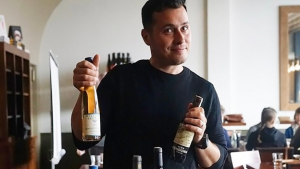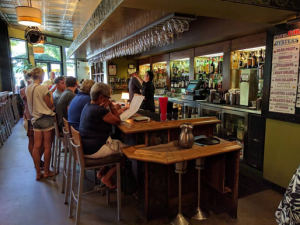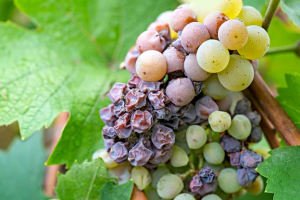We’ve written about Dry Creek Vineyard (www.drycreekvineyard.com) before, but in a different context. We’re very fond of this winery and have visited there often. This year marks their 50th anniversary, which is quite an achievement, and they have been family-run for all that time, which makes the achievement even sweeter. In the interests of openness, we have to say that we’re members of their wine club, but as we often note, we don’t review wine. Power Tasting is about the wine tasting experience.
The theme on Dry Creek’s attractive labels is sailing. As a club member, you can enjoy one of their many member events; pre-pandemic one of them was a sailing day in the San Francisco Bay. Of all the wineries that we know, there is none that has as many club member events as Dry Creek.
 The Dry Creek Vineyard winery. Photo courtesy of the winery.
The Dry Creek Vineyard winery. Photo courtesy of the winery.
And we find that there are many reasons to visit the winery and indulge in a tasting. We do enjoy Dry Creek (the valley) and often spend a day or more in that region of Wine Country. When we do, Dry Creek (the winery) is always on our itinerary. Like much of this region, Dry Creek Vineyard specializes in Zinfandel. They are well known for Sauvignon Blanc and they make some creditable Cabernet Sauvignons and blends as well.
One aspect of a tasting at Dry Creek that is rather unique is that they make seven single-vineyard Zinfandels and four different Bordeaux blends. Not all are available for tasting at any given time, but it’s rare to have the opportunity to compare side-by-side the same grapes made into wine by the same winemaker (Tim Bell). If nothing else, it gets you thinking about the relative influence of winemaking artistry and terroir.
The tasting room is in a vine-covered stone building, fronted by an extensive lawn and some of Dry Creek’s vines. That lawn is a great attraction. It has shade trees, picnic tables and some lawn games for the kids. They’ve even put in a bocce court. It is meant to be welcoming and family-friendly. We have often seen little ones running around outside while their parents sipped and had lunch at nearby tables.
If you do want to have a little picnic, there’s a special advantage at Dry Creek. They’re only four minutes’ walk, according to Google, from the Dry Creek General Store, so you don’t have to pack a picnic in advance. Of course, in California no one walks so it’s a one-minute drive.
 Dry Creek’s “insect garden”. Photo courtesy of the winery.
Dry Creek’s “insect garden”. Photo courtesy of the winery.
Another reason to visit Dry Creek is what they call their “insectary garden”. To be honest, the name put us off for quite a few visits. Eventually we came to recognize that Dry Creek is rather committed to sustainable farming, and insects form a part of the biosystem that they intend to preserve. All very scientific, to be sure, but for the visitor it’s a pretty little garden to walk around in just in front of the grape vines.
In these pandemic times, visits are by appointment only. We can only hope that the disease will pass and the ability to just drop in will return.













